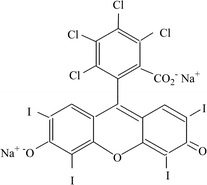Rose Bengal adsorbed on microgranular cellulose: evidence on fluorescent dimers
Abstract
Rose Bengal adsorbed on microgranular cellulose was studied in the solid phase by total and diffuse reflectance and steady-state emission

* Corresponding authors
a
INQUIMAE/DQIAyQF, FCEyN, UBA, Ciudad Universitaria, Pabellón II, 1428 Buenos Aires, Argentina
E-mail:
esr@qi.fcen.uba.ar
Fax: 54 011 4576 3341
Tel: 54 011 4576 3378, Int. 118
Rose Bengal adsorbed on microgranular cellulose was studied in the solid phase by total and diffuse reflectance and steady-state emission

 Please wait while we load your content...
Something went wrong. Try again?
Please wait while we load your content...
Something went wrong. Try again?
H. B. Rodríguez, M. G. Lagorio and E. S. Román, Photochem. Photobiol. Sci., 2004, 3, 674 DOI: 10.1039/B402484B
To request permission to reproduce material from this article, please go to the Copyright Clearance Center request page.
If you are an author contributing to an RSC publication, you do not need to request permission provided correct acknowledgement is given.
If you are the author of this article, you do not need to request permission to reproduce figures and diagrams provided correct acknowledgement is given. If you want to reproduce the whole article in a third-party publication (excluding your thesis/dissertation for which permission is not required) please go to the Copyright Clearance Center request page.
Read more about how to correctly acknowledge RSC content.
 Fetching data from CrossRef.
Fetching data from CrossRef.
This may take some time to load.
Loading related content
